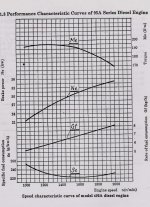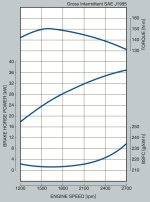tomato coupe
Bronze Member
Neither- my point is a larger displacement engine that has a lower rated power rpm will produce more torque and therefore more horsepower at rpms under the rated rpm compared with an engine that has comparable horsepower at its rated operating rpm. Although the lower rpm engine should accelerate faster thru its rev range because it is producing more torque and therefore hp under the curve.
I f you compare the two graphs you will see that even though the 2000 rpm engine is actually only producing about 48 hp at rated speed compared to the Kubota which produces 50 hp at rated speed, at all operating speeds the 2000 rpm engine is producing much more torque and therefore much more horsepower at any rpm point in its operating range.
Which also means it can do more work on average than the higher revving engine -unless the Kubota is only compared while operating near or at wide open speed.
In a geared tractor configuration the engine is in many applications not running at rated speed but will have more horsepower available especially at low engine speeds - which is an advantage when pulling heavy implements from a dead stop. And many implements in real world conditions.
As i have said before i don't believe the 2000 rpm engine has an advantage in a Hydrastatic drive tractor -where the tractor is operated at peak rpm for the hydros benefit. i do believe it is an advantage in a geared tractor operating many times at lower rpms... i took a few a test rpm horsepower points on the 2000 rpm engine these are ballpark #s but at 1000rpm the 95a engine is @ 30hp the kubota isn't even on the chart but looks to be around 13 hp
@ 1500 rpm 95a @41hp kubota @34 hp
@ 1800 rpm 95a @44hp- Kubota @40 hp
I think due to epa regs and possibly manufacturing costs in materials manufacturers have cranked up the rpms on these diesels to achieve comparable hp #s using smaller and smaller displacement engines- but sacrificed some abilities the lower revving higher torque engines had in the past...
One more thing i am not intending to pick on Kubota it was just the chart already posted.
This seems to be industry wide and if the trend away from geared machines continues maybe it won't even matter because most hydro machines are operated at near rated rpms anyway... JMO and:2cents:
If you want to compare the horsepower of these two engines, you should do it as a fraction of the maximum operating RPM.
Doing so, you get the following:
Kubota Engine
2700 RPM (100%) 50 HP (100%)
2430 RPM (90%) 47 HP (94%)
2160 RPM (80%) 44 HP (88%)
1890 RPM (70%) 39 HP (78%)
1620 RPM (60%) 35 HP (70%)
1350 RPM (50%) 28 HP (56%)
95a Engine
2000 RPM (100%) 48 HP (100%)
1800 RPM (90%) 45 HP (94%)
1600 RPM (80%) 42 HP (88%)
1400 RPM (70%) 39 HP (81%)
1200 RPM (60%) 34 HP (71%)
1000 RPM (50%) 29 HP (60%)
where the numbers in parentheses are the percentage of the values at maximum operating RPM.
When compared this way, the 95a engine still has a horsepower advantage over the Kubota at lower RPMs, but it is very slight. The largest advantage (60% - 56% = 4%) occurs when the engines are run at 50% of their maximum RPMs.
Cheers

